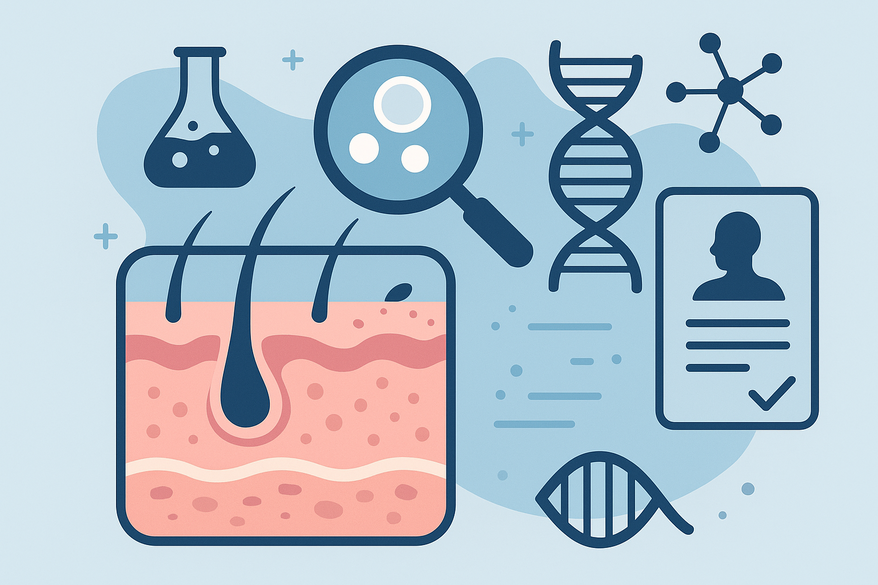Understanding Genetic Indicators in Skin Conditions: Enhancing Diagnosis and Personalized Care
Explore how genetic indicators in skin conditions improve early diagnosis, guide personalized treatment, support risk assessment, and shape dermatology's future.

Estimated reading time: 8 minutes
Key Takeaways
- Genetic indicators are DNA variations that influence skin disease risk and progression.
- Key markers include filaggrin variants in eczema and HLA-C alleles in psoriasis.
- Diagnostic tools like WES and GWAS enable early detection and precision therapies.
- Challenges such as genetic heterogeneity and privacy concerns require careful interpretation.
- Future integration of multi-omics and AI promises truly personalized dermatology.
Table of Contents
- Introduction
- 1. Understanding Genetic Markers
- 2. Key Examples of Genetic Indicators
- 3. The Diagnostic Value of Genetic Testing
- 4. Challenges in Genetic Testing
- 5. Future Directions in Personalized Dermatology
- Conclusion
Introduction
Genetic indicators are specific DNA variations—mutations, SNPs, gene deletions—that shape the onset and course of skin diseases. Identifying these markers early equips clinicians with molecular insights to refine diagnoses and tailor therapies to a patient’s unique profile (PMC4952303).
In this guide, we will:
- Define genetic indicators and their role in skin health
- Review key examples across common and rare conditions
- Examine diagnostic methods and benefits
- Discuss interpretation challenges and ethical considerations
- Explore future trends in personalized dermatology
1. Understanding Genetic Markers
Genetic markers—also called indicators—are DNA changes that signal an increased likelihood of skin disease. They can be inherited or arise de novo.
How They Occur
- Hereditary transmission: Variants passed down through families.
- De novo mutations: New alterations arising in egg or sperm cells.
Impact on Skin Biology
- Disruption of structural proteins, such as filaggrin deficiency leading to barrier weakness.
- Dysregulated immune pathways, for example, interleukin gene variants in psoriasis.
Health vs. Disease
- In healthy skin, balanced gene expression maintains barrier function and immune surveillance.
- In disease, mutations can weaken the barrier or overactivate inflammation.
Common Conditions
- Psoriasis
- Atopic dermatitis (eczema)
- Acne
- Alopecia areata
- Darier disease
2. Key Examples of Genetic Indicators
Examining specific markers reveals why certain individuals develop particular skin disorders:
Psoriasis
- Susceptibility loci: Variants in IL23R, IL12B, and HLA-C*06 raise disease risk.
- Non-coding RNAs: miR-146a, miR-203, miR-21 modulate immune cell activity (PMC4200211).
Atopic Dermatitis
- FLG (filaggrin) loss-of-function variants occur in ~10% of Europeans, leading to barrier dysfunction and higher eczema risk.
Skin Cancer
- Melanoma: Germline mutations in CDKN2A impair tumor suppression.
- Non-melanoma: TP53 variants drive basal and squamous cell carcinomas.
Rare Mendelian Dermatoses
- Darier Disease: ATP2A2 mutations cause keratosis follicularis (MedlinePlus).
- Epidermolysis Bullosa Simplex: KLHL24 variant highlights de novo mutation impact.
3. The Diagnostic Value of Genetic Testing
Genetic testing unlocks the power of these indicators by confirming diagnoses and guiding care.
Current Methods
- Whole Exome Sequencing (WES) for rare dermatoses.
- Genome-Wide Association Studies (GWAS) for common loci.
- miRNA expression profiling to reveal non-coding RNA patterns.
Advantages
- Early detection: Identifies individuals before symptoms manifest.
- Precision medicine: Targets therapies like IL-23 inhibitors to genetic subtypes.
- Family counseling: Offers risk estimates and preventive strategies.
For a non-invasive way to combine genetic insights with real-time skin monitoring, the AI-powered Skin Analysis App provides instant feedback on visible features and molecular risk factors.

4. Challenges in Genetic Testing
Despite its promise, genetic testing poses several hurdles:
Genetic Heterogeneity
- Multiple genes with variable penetrance can complicate interpretation.
Gene–Environment Interactions
- Lifestyle, nutrition, and epigenetic factors influence disease expression.
Accessibility & Cost
- High costs and limited lab access restrict testing in some regions.
Ethical & Privacy Issues
- Managing sensitive genetic data demands strict confidentiality.
5. Future Directions in Personalized Dermatology
Emerging trends promise to deepen the role of genetic indicators:
Research & Technology
- Next-Generation Sequencing (NGS) with multi-omics integration.
- AI-driven variant interpretation for risk prediction.
Therapeutic Innovation
- Targeted biologics directed at cytokine pathways, tailored to genotype.
- Gene editing (CRISPR) in preclinical studies for Mendelian dermatoses.
Clinical Adoption
- Declining sequencing costs will expand routine genetic panels.
- Genotype-based guidelines will standardize diagnosis and management.
Patient insight: Future dermatology visits may include a simple cheek-swab test for key variants, paving the way for truly personalized skin care.
Conclusion
- Defined the molecular roles of genetic indicators.
- Reviewed key markers in common and rare skin diseases.
- Outlined diagnostic methods like WES, GWAS, and miRNA profiling.
- Discussed challenges in data interpretation and ethical handling.
- Highlighted future trends with multi-omics and gene editing.
Integrating genetic data into routine practice will drive better outcomes and usher in an era of personalized dermatology.
FAQ
- What are genetic indicators in skin conditions?
Answer: They are DNA variations—mutations, SNPs, deletions—that correlate with the risk, onset, or progression of dermatological diseases. - How does genetic testing improve diagnosis?
Answer: Tests like WES and GWAS identify causative variants, enabling early detection and tailored treatment plans. - Are there privacy concerns with genetic testing?
Answer: Yes, handling sensitive genetic data requires strict confidentiality and often the involvement of a genetic counselor. - Will genetic profiling become routine in dermatology?
Answer: As sequencing costs decline and guidelines emerge, genetic screening panels are likely to become standard practice. - Can lifestyle factors affect genetic risk?
Answer: Absolutely—gene–environment interactions mean nutrition, stress, and skin care also influence disease expression.





